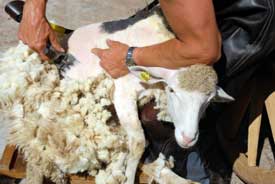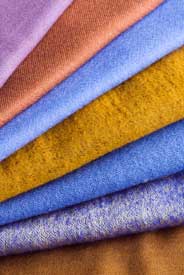The Wonders of Wool Fabric - A Beautiful And Practical Sewing Choice
Wool fabric is an animal based textile. It is different from hair or fur in that it is much more coarse and crimped along the follicle. This gives it the unique ability to stick together and form threads.
Although wool is most commonly produced by different types of sheep, it is also produced by goats, llamas and even certain types of rabbits.
How Is Wool Made?
The annual growing season for a coat of wool is usually one year.

To harvest the wool, or fleece at the end of each growing season, a wool farmer will have his animals sheared. This is a more complicated version of a haircut.
The fleece is to be sheared off in one piece. This can been done in two to three minutes by a professional. This procedure does not harm the animals in any way. They return to the pasture cold and silly looking but no worse for the wear, off to grow another coat over the next year.
The fleece is now graded and sorted. That is, the workers remove any damaged or unusable fleece. The next step is to sort the remaining wool according to the quality of its fibres. The workers look for qualities such as strength, color, crimp (waviness), and fineness (diameter).
The fleece is now washed to remove any left over organic matter and dirt by hand or with a more intensive chemical cleaning. The technique used depends on the scale of the operation and if the wool will be organic and naturally produced.
The fleece is then combed out, or carded and spun either into thread or yarn.

The thread can then be colored and woven into fabric of varying weights and purposes. Wool can be used to make many different weights of fabric.
This can range from the ultrafine and lightweight summer weight wool suiting to a dense centimeter thick felted coating.
Wool is even made into solid felt upwards of an inch thick. Wool felt is created through a process of carding, boiling, pressing and chemically treating the fibers until they become one homogeneous piece of textile.
Here's a link to more great information about
Wool Fabrics .
Why Is Wool Such A Popular Fabric?
Where Can I Buy Wool Online?
As the prices of wool vary greatly depending on the type and quality, do some shopping around to find out where the deals are. Compare prices and discover where to find excellent quality and variety online with the convenience of shopping at home.
I've found that
Fabric.com
has a wonderful collection - just about anything you could want in the line of wool fabric and accessories will be found here. It is
a popular online store for all your sewing needs. I've bought from them and have had very positive experiences.
Caring For Your Creations Made From Wool
When cleaning your wool fabric, it is important to treat it gently. Hand wash it in warm, not hot water to avoid felting. Block dry, that is, lay it out over a flat, absorbent surface like a towel on a countertop. Hung wool will stretch as it dries, and will shrink if put in a dryer. Please read more on
Caring for Wool if you're taking on a project and need a bit more information.
Related Articles




